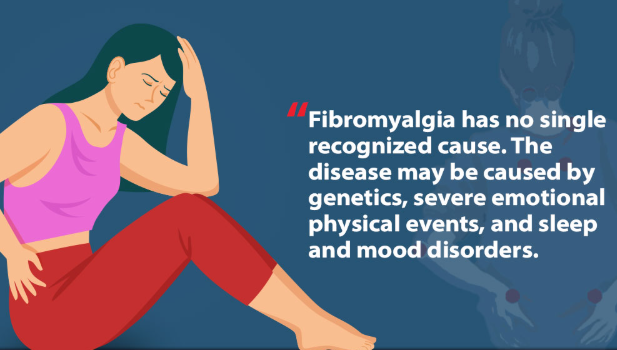Fibromyalgia and anxiety are two conditions that often go hand in hand, but they are distinct disorders with different causes and treatments. Many people with fibromyalgia experience chronic anxiety, and individuals with anxiety disorders sometimes develop widespread pain similar to fibromyalgia.
Understanding the differences, similarities, and the relationship between fibromyalgia and anxiety can help with proper diagnosis and management.
What is Fibromyalgia?
Fibromyalgia is a chronic pain disorder that affects the nervous system’s ability to process pain signals properly. It leads to widespread musculoskeletal pain, fatigue, and cognitive difficulties (“fibro fog“). The exact cause of fibromyalgia is unknown, but abnormal pain processing in the brain, genetic factors, and stress play a significant role.
Common Symptoms of Fibromyalgia
- Widespread pain affecting muscles, joints, and soft tissues
- Fatigue and exhaustion, even after sleep
- Cognitive dysfunction (“fibro fog“), including trouble concentrating and memory issues
- Sleep disturbances, including non-restorative sleep and frequent awakenings
- Increased sensitivity to pain, light, sound, and temperature
- Mood disorders, such as anxiety and depression
- Digestive issues, including irritable bowel syndrome (IBS)
The Link Between Fibromyalgia and Mental Health
- Many people with fibromyalgia experience anxiety and depression due to chronic pain and disability.
- The brain’s pain regulation system overlaps with areas responsible for emotional processing, making fibromyalgia patients more vulnerable to anxiety.
- Poor sleep and chronic stress worsen both pain and anxiety.
What is Anxiety?
Anxiety is a mental health disorder characterized by excessive worry, nervousness, and fear that can interfere with daily life. While mild anxiety is a normal response to stress, chronic anxiety can become overwhelming and lead to physical symptoms that mimic other health conditions, including fibromyalgia.
Common Symptoms of Anxiety
- Excessive worrying and overthinking
- Restlessness, irritability, and nervousness
- Difficulty concentrating and feeling mentally overwhelmed
- Muscle tension, headaches, and body aches
- Fatigue and exhaustion due to constant stress
- Rapid heartbeat, sweating, and dizziness
- Digestive issues, such as nausea and diarrhea
How Anxiety Affects the Body
- Anxiety activates the fight-or-flight response, leading to muscle tension and physical pain.
- Chronic anxiety increases stress hormones (cortisol, adrenaline), which can worsen pain sensitivity and fatigue.
- Sleep disturbances are common in anxiety, which can make fibromyalgia symptoms worse.
Key Differences Between Fibromyalgia and Anxiety
While fibromyalgia and anxiety have overlapping symptoms, they are separate conditions with distinct causes and effects.
| Feature | Fibromyalgia | Anxiety |
|---|---|---|
| Primary Cause | Abnormal pain processing in the nervous system | Overactivity of the brain’s fear and stress response |
| Pain Symptoms | Widespread musculoskeletal pain, tenderness | Muscle tension, headaches, general discomfort |
| Fatigue Source | Poor sleep quality, nervous system dysfunction | Chronic stress, racing thoughts, sleep disturbances |
| Cognitive Issues (“Brain Fog”) | Trouble with memory and concentration | Difficulty focusing due to excessive worry |
| Sleep Disturbances | Non-restorative sleep, frequent awakenings | Insomnia, racing thoughts, nightmares |
| Emotional Impact | Secondary anxiety and depression from chronic pain | Primary emotional distress, panic, and fear |
| Diagnosis | Clinical criteria based on pain, sleep, and cognitive symptoms | Psychological evaluation based on emotional and physical symptoms |
| Treatment Approach | Pain management, exercise, sleep therapy | Stress management, therapy, medication |
Can Anxiety Cause Fibromyalgia Symptoms?
Yes, chronic anxiety can mimic fibromyalgia symptoms in some individuals. When the body remains in a constant state of stress, muscle tension, fatigue, and pain can develop, resembling fibromyalgia. However, anxiety-induced pain typically improves when stress levels are reduced, whereas fibromyalgia pain persists regardless of stress reduction.
Signs Your Symptoms May Be Anxiety-Related Rather Than Fibromyalgia
- Pain is triggered by stressful situations and reduces when relaxed.
- Symptoms fluctuate rapidly based on emotions and thoughts.
- Muscle tension is a primary complaint, rather than deep musculoskeletal pain.
- You experience panic attacks, excessive worry, or phobias.
If these symptoms match your experience, anxiety may be the main cause rather than fibromyalgia. However, a proper diagnosis by a healthcare provider is essential.
How Are Fibromyalgia and Anxiety Diagnosed?
Fibromyalgia Diagnosis
Fibromyalgia is diagnosed through:
- Widespread pain index (WPI) and symptom severity scale (SSS)
- Symptoms lasting at least three months
- Exclusion of other conditions like arthritis, autoimmune diseases, and anxiety disorders
Anxiety Diagnosis
Anxiety is diagnosed based on:
- Psychological assessments and questionnaires
- Observation of persistent worry and stress-related symptoms
- Impact of anxiety on daily life and well-being
Treatment Approaches
Fibromyalgia Treatment
- Medications:
- Pain relievers (pregabalin, duloxetine, amitriptyline)
- Sleep aids and muscle relaxants
- Lifestyle Changes:
- Gentle exercise (yoga, stretching) to reduce stiffness
- Cognitive-behavioral therapy (CBT) for pain management
- Healthy sleep habits to improve rest
- Stress Management:
- Meditation, deep breathing, and relaxation techniques
Anxiety Treatment
- Medications:
- Therapy:
- Cognitive-behavioral therapy (CBT) to reframe anxious thoughts
- Exposure therapy for specific fears or phobias
- Lifestyle Changes:
- Mindfulness and meditation to reduce overthinking
- Regular exercise to release tension
- Breathing exercises to calm the nervous system
Can You Have Both Fibromyalgia and Anxiety?
Yes, many people with fibromyalgia also have anxiety, and vice versa. Research suggests that chronic pain conditions increase the risk of anxiety disorders, while untreated anxiety can worsen pain perception.
Why Do Fibromyalgia and Anxiety Coexist?
- Chronic pain leads to emotional distress, increasing anxiety levels.
- Sleep problems in fibromyalgia contribute to anxiety and mood disturbances.
- Stress-related neurotransmitter imbalances (serotonin, dopamine, norepinephrine) affect both pain and anxiety.
Managing Both Conditions Together
If you have both fibromyalgia and anxiety, a combined treatment approach is best:
- Address pain and sleep problems (pain medications, sleep therapy)
- Manage stress and anxiety (CBT, relaxation techniques, mindfulness)
- Adopt a healthy lifestyle (exercise, balanced diet, sleep hygiene)
- Consider medication if necessary (antidepressants for both pain and anxiety)
Conclusion: How to Tell the Difference
While fibromyalgia and anxiety have overlapping symptoms, they are distinct conditions with different causes. Fibromyalgia is a chronic pain disorder with neurological origins, whereas anxiety is a mental health condition driven by excessive worry.
If your symptoms change based on stress levels, anxiety might be the root cause. If pain persists regardless of mood, fibromyalgia could be the culprit.
A proper medical evaluation is essential to determine the right diagnosis and treatment approach. Managing both fibromyalgia and anxiety together can significantly improve quality of life and symptom relief.

Click Here to Visit the Store and find Much More….
For More Information Related to Fibromyalgia Visit below sites:
References:
Fibromyalgia Contact Us Directly
Click here to Contact us Directly on Inbox
Official Fibromyalgia Blogs
Click here to Get the latest Chronic illness Updates
Fibromyalgia Stores

